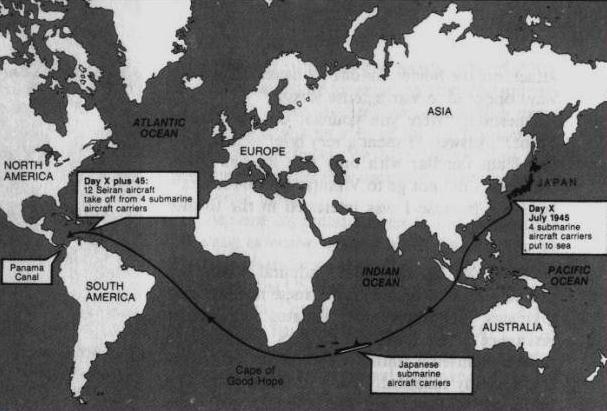Japanese Plan to Attack Panama Canal: 1942-1945
"At the end of May 1945, final preparations for a special secret mission were taking place at the aerial operations division of Imperial Japanese Headquarters. The secret operation was intended to shatter the USA like the raid on Pearl Harbor: It was a bombing raid on the Panama Canal. The plan was born right after the Doolittle Raid, the first US raid on Tokyo back in April 1942. Ever since, Japanese strategists had been determined to launch a counterstrike against the USA. At the instigation of Admiral Yamamoto, a series of giant class I-400 submarines were ordered, each able to carry 3 special-duty aircraft. These 5,223-ton submarines, with a range of 37,500 nautical miles, were twice as large as th largest vessels in the US Navy and could remain at sea for 4 months without added fueling. A catapult stretched from the spacious cylinder-shaped hangar in the starboard hold, forward to the bow.
"The aircraft built to take off from the submarines were twin-seater Aichi M6A1 Seiran seaplanes specially designed for the Panama Canal operation. The Seirans were all equipped with German Daimler-Benz DB 601 A 1,400- horsepower engines and were designed as the world’s first ‘throwaway airplanes’ , which would drop off the crew after the raid, be ditched beside the submarines and sink at once.[1] To help insure that the raid on the Canal came as a surprise, the Japanese planned to attack not from the east, but from the Caribbean Sea on the west. The four submarine aircraft carriers would launch their 12 Seiran aircraft shortly before daybreak. A twenty-five-year-old pilot, Lt. Atsushi Asamura, was assigned to lead the operation, which was planned for mid-July 1945. The plan was to drop bombs and torpedoes on the canal gates and other nerve-centers of the Panama Canal. As soon as the crews had been taken back on board and the aircraft sunk, the submarine motherships would submerge as rapidly as possible.
"The Seiran unit had been formed on 15 December 1944 and was officially known as the 613th Air Corps. Its commander was Captain Ariizumi, an officer of the 1st Japanese Submarine Flotilla to which the giant submarines belonged. The new unit was under the overall command of the Sixth Fleet in Kure. Two of the best-known members of the newly-formed Seiran Corps were officers N.Fujita and S.Okuda, both of whom had been involved in the first and only previous air raid on the USA, from Submarine I-25 on 9 September 1942. The Yokosuka E14Y1 that they had used on that raid, was also a direct ancestor of the Seirans.
"The Seiran and submarine crews began minutely-prepared exercises on 2 April 1945. It was determined that 1,760 pounds was the heaviest bombload the Seirans could risk carrying on their catapult takeoff. The hangers had been camouflaged with dummy chimneys to disguise the huge submarines from US reconnaissance planes. …
“On 25 June 1945, Imperial Japanese Headquarters halted preparations for the Japanese 1st Submarine Flotilla to attack the Panama Canal, and issued new orders: In view of the American threat to the Japanese islands, the 12 Seiran aircraft were ordered to find a suitable opportunity to launch a kamikaze raid (Operation Hikari) against US aircraft carriers; but the surrender came before the operation was carried out.”[2]
[1]They were ordered in mid-1942, which was before the kamikaze and the German cobble-jobs where a manned fighter was attached atop an unmanned explosives-loaded bomber, the latter of which was released as a huge flying bomb.







